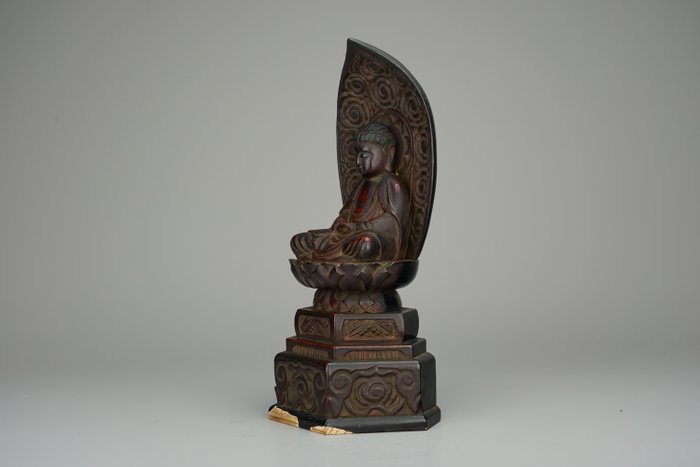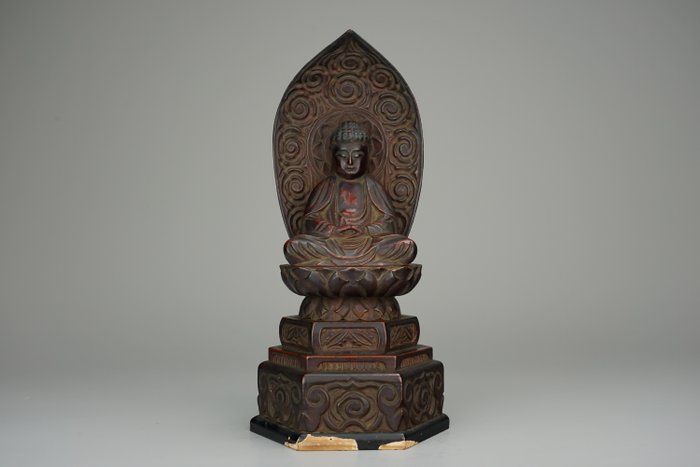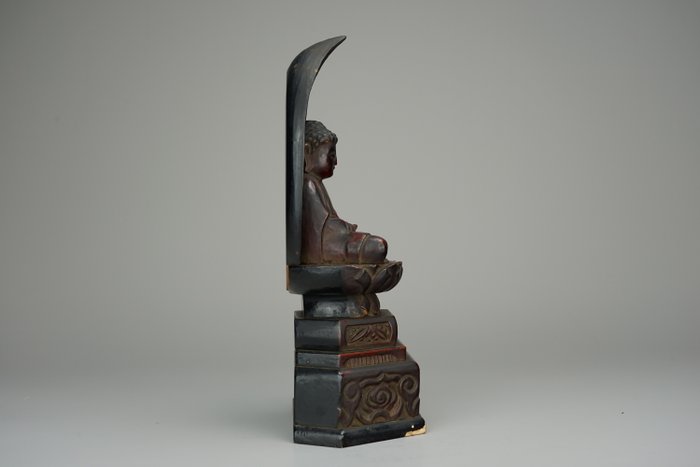




Amida Nyorai (Amitābha) Buddha - Gilded, Lacquer, Wood - Japan - Shōwa Period (1926-1989)

Details
Description from the seller
Amida Nyorai (Amitābha) Buddha - Gilded, Lacquer, Wood - Japan - Shōwa Period (1926-1989)
En Edo-perioden forgyldt lakeret træ 阿弥陀如来 Amida Nyorai (Amitābha) Buddha-figur siddende i en medierende positur, der viser samāhitā-mudraen, typisk for Amida Buddha. Buddhaen sidder på en lotustrone med en smukt udskåret sekskantet base. Forgyldningen er for det meste slidt/gnidet af, men stadig synlig på bagsiden af Buddha. Buddhaen, dens glorie og dens trone er indskrevet, hvoraf nogle er i stand til at oversætte: Buddha: "有場更家" "Ariba Saraie" — Buddha-statuen blev sandsynligvis doneret af eller dedikeret til en person ved navn "Ariba Saraie". Halo: "開眼" (kaigan) - Dette betyder "åbning af øjnene" og er et udtryk, der bruges i buddhismen. Det refererer til en indvielsesceremoni, hvor øjnene på en statue symbolsk "åbnes" og bringer den til live åndeligt. "明三左" (Myōzō) - Dette kan referere til et navn, potentielt på en kunstner eller munk, der er involveret i statuens indvielse. "大和尚" (daio shō) - "Store Munk" eller "Store buddhistpræst," "慧文" (Emon eller Ebumi) - Dette er sandsynligvis et buddhistisk navn på den person, der foretog ceremonien. Grundlag: "昭和十四年" — (Showa jūyōnen) henviser til det 14. år af Showa-æraen, hvilket svarer til 1939 i den vestlige kalender. "六月大众德之目" - "I juni samles den store forsamling (eller menighed) til fokus på dyd." Resten af teksten er svær at oversætte. Samāhitā-mudraen ses på ingen anden repræsentation end Amida Buddhas. Det betyder en meditation, hvor al den psykiske kraft er samlet et bestemt sted i maven, lige under navlen, mellem rygsøjlen og maven. Amida Nyorai (Amitābha) er den vigtigste Buddha i Pure Land Buddhism. I Vajrayana-buddhismen er Amitābha kendt for sin levetid, dømmekraft, rene opfattelse og rensning af aggregater med dyb bevidsthed om tomheden i alle fænomener. Ifølge nogle sutraer besidder Amitābha uendelig fortjeneste, der er et resultat af store gerninger dyrket gennem hans utallige tidligere liv som Dharmākara Bodhisattva. Navnet Amitābha oversættes til "uendeligt lys." Dimensioner (ca.): Buddha: H8,2 cm Trone og glorie: H22,5 x B11,2 x 7,3 cm Stand: I generelt god stand, statuen har en del laktab, (forgyldt-)lakslid og en del ophobet snavs/støv. Billederne giver flere detaljer om tilstanden. Grunden sælges "som den er". Forsendelse: Varen vil blive forsvarligt pakket og sendt med forsikring. Selv du vil pakke varen meget sikkert, lille tab af lak kan ske under forsendelsen.

